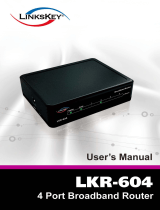Introduction .............................................................................. 4
Section 1: Hardware .............................................................................. 7
1.1 Back Panel .............................................................................. 7
1.2 Front Panel .............................................................................. 8
1.3 Setup Diagram .............................................................................. 9
Section 2: Quick Setup .............................................................................. 10
2.1 Getting Started .............................................................................. 10
2.2 Quick Setup Wizard .......................................................................... 15
2.2.1 Time Zone ............................................................................ 15
2.2.2 Broadband Type ................................................................... 16
2.2.2.1 Cable Modem ........................................................... 17
2.2.2.2 Fixed-IP xDSL .......................................................... 18
2.2.2.3 PPPoE ...................................................................... 19
2.2.2.4 PPTP ........................................................................ 21
2.2.2.5 L2TP......................................................................... 23
2.2.2.6 Telstra BigPond ........................................................ 25
Section 3: General Setup .............................................................................. 26
3.1 System .............................................................................. 26
3.1.1 Time Zone ............................................................................ 27
3.1.2 Password Settings ............................................................... 27
3.1.3 Remote Management ........................................................... 28
3.2 WAN .............................................................................. 30
3.2.1 Dynamic IP Address ............................................................. 30
3.2.2 Static IP Address .................................................................. 30
3.2.3 PPPoE .............................................................................. 30
3.2.4 PPTP .............................................................................. 30
3.2.5 L2TP .............................................................................. 31
3.2.6 Telstra BigPond .................................................................... 31
3.2.7 DNS .............................................................................. 31
3.2.8 DDNS .............................................................................. 32
3.3 LAN .............................................................................. 33
3.4 Wireless .............................................................................. 34
3.4.1 Basic .............................................................................. 35
3.4.2 Advanced.............................................................................. 39
3.4.3 Security .............................................................................. 40
3.4.3.1 WEP Only.............................................................. 40
3.4.3.2 802.1x Only ........................................................... 42
3.4.3.3 802.1x WEP Static Key ......................................... 42
3.4.3.4 WPA Pre-Shared Key............................................ 43
3.4.3.5 WPA RADIUS........................................................ 44
3.4.4 Access Control ..................................................................... 45
3.5 QoS .............................................................................. 46
3.6 NAT .............................................................................. 49
3.6.1 Port Forwarding .................................................................... 49
3.6.2 Virtual Server........................................................................ 50




















